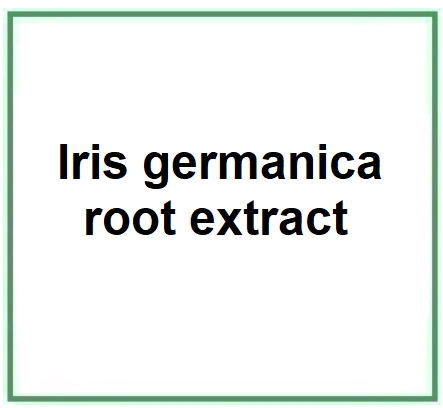Iris germanica root extract is obtained from Iris germanica (a plant belonging to the botanical family Iridaceae) known for its beautiful and striking flowers. In addition to its ornamental use, the root of this plant, often referred to as Orris root, has been valued in various cultures for its fragrance and medicinal properties. The root extract is particularly valued in perfumery and cosmetics.

Name breakdown and function of the components
- Iris germanica - This is the scientific name for the German Iris or Bearded Iris, a perennial ornamental plant.
- Root - Refers to the underground part of the plant. The roots of Iris germanica contain compounds such as iridins, mucilages, and other bioactive components.
- Extract - Indicates that the product is a concentration of some components of the root.
Description and function of the raw materials used in production
- Iris germanica roots - The primary source of iridins, mucilages, and other beneficial compounds.
- Solvent (like water or ethyl alcohol) - Used to extract the beneficial compounds from the roots.
- Summary of the extraction process step by step
Collection and preparation of the roots - Roots are harvested and cleaned from impurities.
- Shredding - The roots are shredded into smaller pieces to increase the surface area in contact with the solvent.
- Extraction - The shredded material is soaked in the solvent for a specified period, allowing the compounds to diffuse into the solvent.
- Filtration - Once extraction is complete, the solution is filtered to remove any residual solid particles.
- Evaporation - The solvent is then evaporated, leaving behind the concentrated Iris germanica extract.
- Stabilization and preservation - The extract may be further treated or stabilized for long-term storage.
What it is for and where
Cosmetics
Skin conditioning agent. It is the mainstay of topical skin treatment as it has the function of restoring, increasing or improving skin tolerance to external factors, including melanocyte tolerance. The most important function of the conditioning agent is to prevent skin dehydration, but the subject is rather complex and involves emollients and humectants that can be added in the formulation.
CAS 85085-39-8
EC number 285-368-2
Commercial applications
Cosmetic and Skincare Products: Due to its emollient and cooling properties, it's incorporated into creams, lotions, and other skincare items.
Perfumery: Orris root is cherished for its unique fragrance and is often a key ingredient in many luxury perfumes.
Traditional Medicine: Traditionally, the iris root extract has been employed for its anti-inflammatory properties and as a means to purify the skin.
Properties
Emollient: Helps to moisturize and soften the skin.
Cooling: Imparts a refreshing sensation to the skin.
Anti-inflammatory: Assists in reducing skin inflammation and irritation.
Studies
The phytochemical composition of Iris germanica includes antioxidants (1) and other interesting bioactive compounds, flavonoids and polyphenols (2).
References_____________________________________________________________________
(1) Sayyed K, Hdayed I, Tabcheh M, Abdel-Razzak Z, El-Bitar H. Antioxidant properties of the Lebanese plant Iris x germanica L. crude extracts and antagonism of chlorpromazine toxicity on Saccharomyces cerevisiae. Drug Chem Toxicol. 2022 May;45(3):1168-1179. doi: 10.1080/01480545.2020.1810261.
(2) Roger B, Jeannot V, Fernandez X, Cerantola S, Chahboun J. Characterisation and quantification of flavonoids in Iris germanica L. and Iris pallida Lam. resinoids from Morocco. Phytochem Anal. 2012 Sep-Oct;23(5):450-5. doi: 10.1002/pca.1379.
![]() Iris germanica root extract
Iris germanica root extract 


